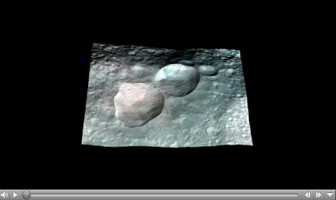
Click on the image for the videoThis movie from NASA's Dawn mission shows a 3-D rendering of the craters that make up the "snowman" feature on the giant asteroid Vesta. From left to right in the initial frame, the craters are named Marcia (36 miles or 58 kilometers across), Calpurnia (31 miles or 50 kilometers across) and Minucia (14 miles or 22 kilometers across).
The images are color enhanced with visible and infrared data from Dawn's framing camera and wrapped on a topographical model of Vesta. In this color scheme, red was assigned the 0.75 micron wavelength filter; green was assigned the 0.92 micron wavelength; blue was assigned the 0.98 micron wavelength. Areas in red indicate fresh material excavated from depth. The topographic model of Vesta used here is an ellipsoid that fits the body's average shape.
The images were obtained during Dawn's high-altitude mapping orbit, which averaged about 420 miles (680 kilometers) in altitude and took place from Sept. 30 to Nov. 2, 2011. The resolution during that orbit was about 200 feet (60 meters) per pixel.
The Dawn mission to Vesta and Ceres is managed by NASA's Jet Propulsion Laboratory, a division of the California Institute of Technology in Pasadena, for NASA's Science Mission Directorate, Washington. UCLA is responsible for overall Dawn mission science. The Dawn framing cameras were developed and built under the leadership of the Max Planck Institute for Solar System Research, Katlenburg-Lindau, Germany, with significant contributions by DLR German Aerospace Center, Institute of Planetary Research, Berlin, and in coordination with the Institute of Computer and Communication Network Engineering, Braunschweig. The framing camera project is funded by the Max Planck Society, DLR and NASA/JPL.
More information about Dawn is online at http://www.nasa.gov/dawn and http://dawn.jpl.nasa.gov.

